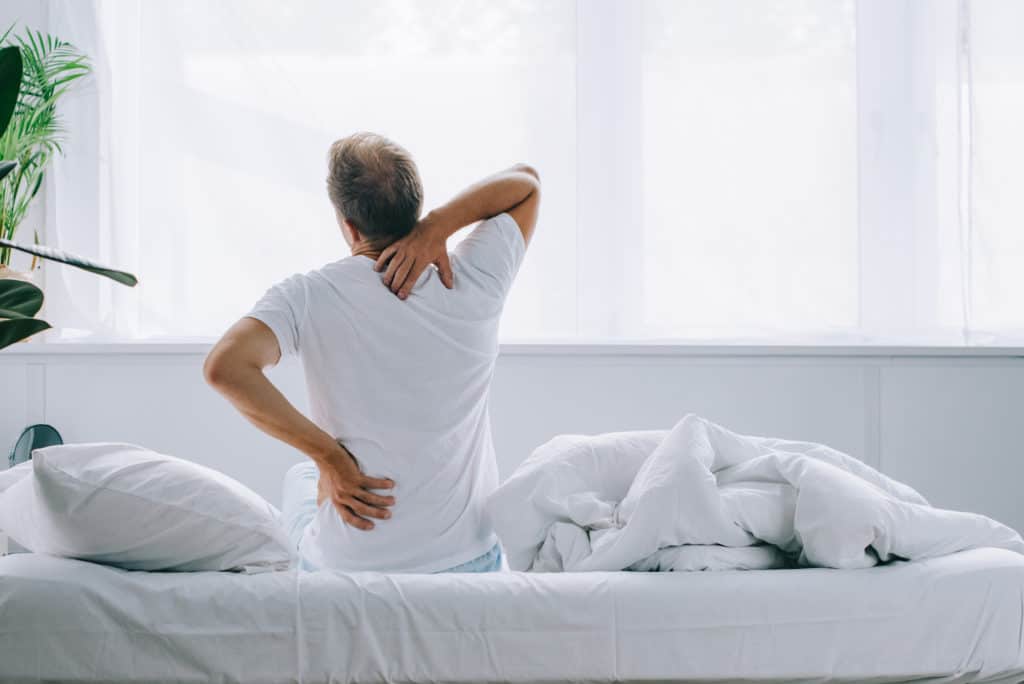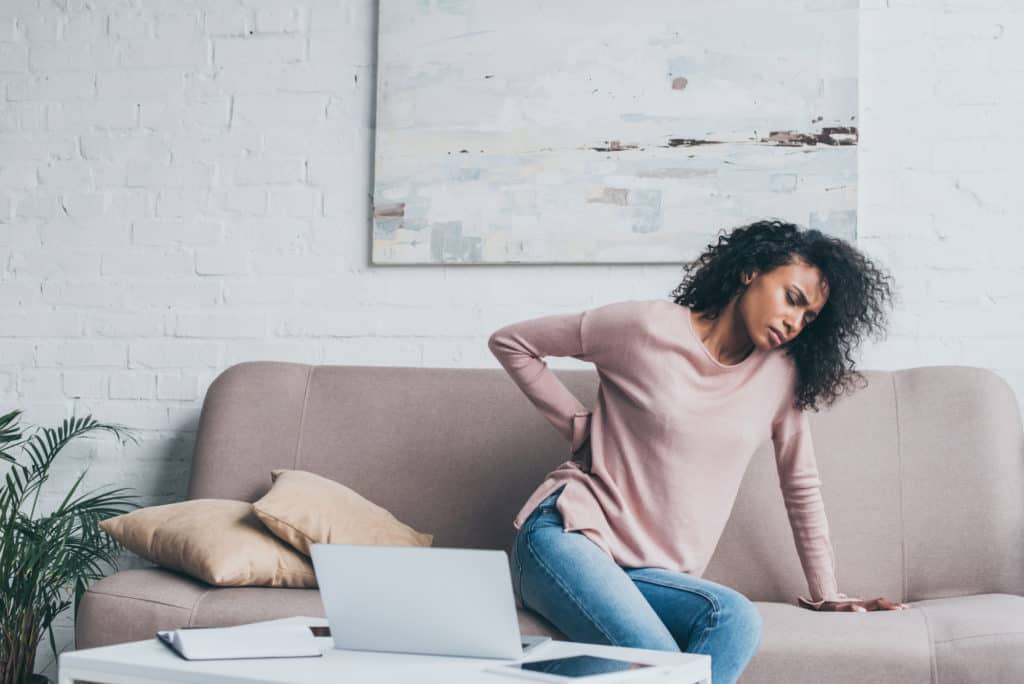
Are you struggling to sleep because of lower back pain?
Thanks to evolving scientific research and multiple sleep studies, we now know how beneficial it is to get good quality sleep. This connection with rest is especially true when you’re living with chronic pain. Everything feels better after a good night’s sleep.
If only it were that easy, though, right?
We also know it can be challenging to get to sleep and stay asleep when you’re in pain. It’s a vicious circle.
So, are you getting a good night’s sleep?
The chances are you probably aren’t.
But why is that?
What’s getting in between us and our much-needed rest?
Many of us struggle to get a good 6-8 hours of sleep regularly in the busy, permanently connected modern world of intrusive social media notifications, overflowing email inboxes, 24/7 news reports, and sleep-disturbing blue light. But, of course, the reason is different for everyone.
For you, it could be light pollution, stress, or an uncomfortable bed. For others, it could be allergies, fibromyalgia, arthritis, or a problem with their circadian rhythm. But for this article, we’re going to look at sleep and lower back pain specifically.
What Causes Lower Back Pain?

While we feel back pain over a wide area from the neck to the hips, the most common form of back pain is a pain in the lower back (also known as the lumbar region).
Lower back pain manifests in various ways. But it’s usually felt as a dull ache or throb that is there most of the time, or it’s a stabbing sensation that comes and goes in sharp waves.
As a result of lower back pain, everyday activities become challenging – particularly movement and exercise or sitting or standing for long periods. For this reason, statistics often cite lower back pain as one of the main reasons why Americans take sick days. Fortunately, though, we can do many things to treat lower back pain – especially after we find the root cause.
But, for many people who don’t seek treatment, it’s a hugely problematic issue that keeps them awake at night.
So, what can cause it?
The Causes of Lower Back Pain

In today’s world, the potential causes of lower back pain are many and varied. But at the top of that long list is our lifestyles and unhealthy daily habits.
Sadly, more and more North Americans are leading a sedentary lifestyle. We’re stuck at our desks all day and not getting enough fresh air, Vitamin D, movement, or exercise. This situation is further compounded by poor posture and ergonomics and lack of lumbar support while sitting.
Annoyingly though, even for those who are active, there is no escape from the potential to experience lower back pain. Unfortunately, you may be one of the unlucky ones who has picked up a lower back injury while exercising. This scenario is a common complaint when muscles aren’t stretched and warmed up properly first.
But it may surprise you to learn that one of the most common culprits for lower back pain is sleeping itself. Unusual sleeping positions, poor spinal alignment, and the bidirectional relationship with poor quality/lack of sleep can also significantly contribute to the lower back in all its forms.
How To Get To Sleep With Lower Back Pain

So, now we know the cause. How exactly do you get a good night’s sleep with lower back pain?
Change Your Sleeping Position
This one might seem straightforward, but it’s pretty hard to accomplish if you’ve been sleeping in the same position for a long time. It may have been years that you’ve been sleeping “wrong,” but the symptoms are only just starting to show themselves. However, once you rectify it, you may find that your pain disappears, and suddenly you’re able to sleep through the night for 7-8 hours without interruption.
But how do you sleep “right”?
Well, it’s essential to find a position that is both comfortable and one that also keeps your spine aligned. But, of course, the ideal position is different for everyone.
Try: Sleeping on your side with a pillow between your legs
This sleeping position helps because the pillow keeps your hips, pelvis, and spine in better alignment to ease your discomfort and prevent further lower back pain.
Try: Sleeping in the fetal position
This sleeping position involves sleeping on your side and tucking your knees – like a baby inside the womb. This position may be beneficial if the pain is stopping you from getting to sleep.
Ease your Lower Back Pain before Sleeping
So, sleeping positions may help to ease your back pain when you are in bed. But it can be helpful to try and reduce your pain levels before you get into bed and try to sleep.
Try: Stretching before bed.
Find a gentle Yin Yoga routine or bedtime stretching routine on YouTube and make it a habit to follow along before bed. This extra step helps relax your back muscles, and it can help relax your entire body and mind ready to sleep.
Remember, though, if any movement makes your pain worse: stop right away. Ideally, you should check with your doctor or Physiotherapist before starting any new exercise routine, especially if your pain is severe.
Try: Heat therapy
Like gentle movement and stretching, heat therapy helps relax your muscles and reduce inflammation. This relaxation then helps ease your pain and prepare your body for a good night’s sleep.
Using heat helps relax your muscles, and low-temperature therapy or ice packs reduce inflammation and reduce nerve pain. Find the one that works best for you.
Another way to use heat therapy to reduce pain and relax your muscles is to take a relaxing hot bath before bed. To aid with muscle relaxation, you could also consider adding a cup of Epsom salts to your bath.
Other Ways To Improve Your Sleep

So, the above tips and tricks hopefully go some way towards negating the negative impact of lower back pain on your sleep routine. But, as we mentioned earlier, there are several other obstacles that the modern world presents that interferes with the quality of our sleep and, therefore, our pain levels.
So, let’s take a quick look at how to combat them:
First up are the tech devices that we love/hate. They have many adverse effects, but they do have numerous benefits too. For example, if you use your mobile phone or laptop late into the evening after it goes dark. It can impact your sleep by affecting your body’s melatonin production and natural circadian rhythm.
This effect is due to the blue light that the screen on these devices gives off. You can use tools and Apps to dim your screen at set times, or better still, turn off all your devices at least an hour before going to bed. Turn off unnecessary lights too.
Aside from technology and electrical devices, many other things can majorly impact our sleep patterns. For example, caffeine and alcohol should be avoided, particularly in the evening.
It’s proven that sleep quality is poor, and you don’t sleep as well when your liver is required to process alcohol when you’re asleep. Caffeine, too – if consumed close to bedtime, can keep you awake at night. So try not to drink coffee or other caffeine-containing beverages after 2/3 pm.
But one of the best things you can do to make sure you regularly get good quality sleep is to create and follow a sleep routine – a routine that you follow every night before bed.
This habit helps your body improve its natural circadian rhythm, so you fall asleep and stay asleep with ease.
For example, start switching off lights and devices and preparing for bed at the same time every night, and get up at the same time every morning, including the weekend. You could also consider using a sleep cue: a cue to tell your brain that it’s time to sleep – like using lavender essential oil.
How to Banish Back Pain For Good

As you can see, there are some steps you can take at home to try and prevent and treat lower back pain. But lower back pain is miserable, and too many patients suffer in silence. They don’t seek help – mistakenly believing that it will go away on its own. But it doesn’t. They sleep-walk through life feeling terrible until it affects other areas of their health and well-being and contributes to depression, anxiety, stress, and relationship breakdowns.
Don’t put it off any longer – let us help you.
At Gage Physiotherapy, we help men and women in their 40’s, 50′ and 60’s get back to living the life they deserve. Free from the misery of lower back pain and endless sleepless nights.
Not sure whether physiotherapy is right for you?
Why not try one of our free 30-minute consultations with a physiotherapist to find out how we can help you. Choose from a telephone appointment or a Discovery Visit: a taster session at our Hamilton clinic.
Alternatively, get in touch with me through my physiotherapy contact page. I look forward to hearing from you!

